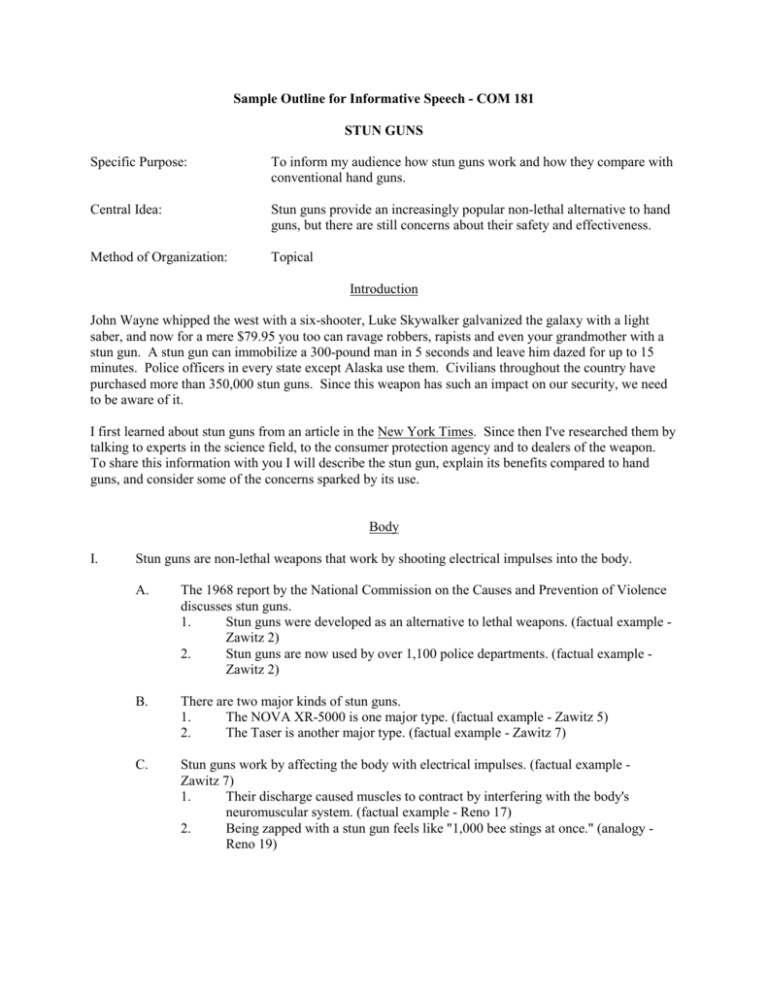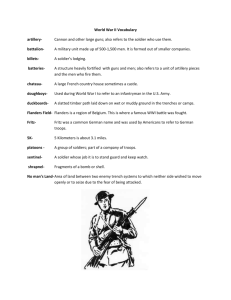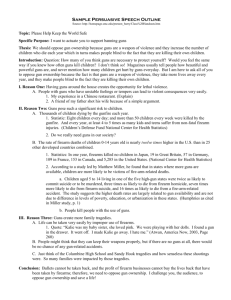Sample Outline for Informative Speech
advertisement

Sample Outline for Informative Speech - COM 181 STUN GUNS Specific Purpose: To inform my audience how stun guns work and how they compare with conventional hand guns. Central Idea: Stun guns provide an increasingly popular non-lethal alternative to hand guns, but there are still concerns about their safety and effectiveness. Method of Organization: Topical Introduction John Wayne whipped the west with a six-shooter, Luke Skywalker galvanized the galaxy with a light saber, and now for a mere $79.95 you too can ravage robbers, rapists and even your grandmother with a stun gun. A stun gun can immobilize a 300-pound man in 5 seconds and leave him dazed for up to 15 minutes. Police officers in every state except Alaska use them. Civilians throughout the country have purchased more than 350,000 stun guns. Since this weapon has such an impact on our security, we need to be aware of it. I first learned about stun guns from an article in the New York Times. Since then I've researched them by talking to experts in the science field, to the consumer protection agency and to dealers of the weapon. To share this information with you I will describe the stun gun, explain its benefits compared to hand guns, and consider some of the concerns sparked by its use. Body I. Stun guns are non-lethal weapons that work by shooting electrical impulses into the body. A. The 1968 report by the National Commission on the Causes and Prevention of Violence discusses stun guns. 1. Stun guns were developed as an alternative to lethal weapons. (factual example Zawitz 2) 2. Stun guns are now used by over 1,100 police departments. (factual example Zawitz 2) B. There are two major kinds of stun guns. 1. The NOVA XR-5000 is one major type. (factual example - Zawitz 5) 2. The Taser is another major type. (factual example - Zawitz 7) C. Stun guns work by affecting the body with electrical impulses. (factual example Zawitz 7) 1. Their discharge caused muscles to contract by interfering with the body's neuromuscular system. (factual example - Reno 17) 2. Being zapped with a stun gun feels like "1,000 bee stings at once." (analogy Reno 19) II. III. Stun guns offer several benefits over conventional hand guns. A. Most importantly, stun guns are not lethal. (factual example) 1. Testimony from Dr. Theodore Bernstein supports this fact. (testimony - FBI Manual 18) 2. Testimony from Dr. Robert Stratbuck supports this fact. (testimony - FBI Manual 18) B. Stun guns can be used in situations in which hand guns might be undesirable. (factual example - Rand) 1. Police can subdue violent individuals. 2. Women and the elderly can resist assaults. 3. Homeowners with children in the house can safely use them. There are also concerns about the use of stun guns. A. Four states have prohibited civilian ownership of stun guns. (factual example - Reno 14) B. Stun guns have been misused. (factual example - Rand) 1. Police have abused suspects. (factual example - Rand) 2. Criminals have committed crimes. (factual example - Rand) C. Stun guns may pose safety hazards. (factual example - Prevention 97) 1. The Consumer Product Safety Commission has issued a warning. (testimony Prevention 98) 2. A Los Angeles hospital has reported injuries. (expert testimony - Jones) D. The effectiveness of stun guns has also been questioned. 1. Prevention Magazine says that NOVA works only half the time. (statistic - McPhee 97) 2. Taser darts can be removed. (factual example - McPhee 101) Conclusion In conclusion, even though stun guns offer certain advantages over hand guns, there are still concerns about them. Yet the day may come when, instead of hearing the sound of John Wayne's six-shooter or the swish of Luke Skywalker's light-saber, you will hear the crackle of a stun gun. Works Cited Jones, Robert J. Telephone interview. 23 Sept. 1994. McPhee, John. “Alternative Self Defense Measures.” Prevention Magazine 22 Feb. 1991: 96-102. Rand, Michael R. Guns and Crime: Handgun Victimization, Firearms, Self Defense, and Firearm Theft. Washington, D.C.: U.S. Dept. of Justice, 1994. Reno, Janet. “Stun Guns in Law Enforcement.” New York Times 25 May 1990: 17-19. United States. Federal Bureau of Investigation Manual. 8th ed. Washington: GPO, 1985. Zawitz, Marianne W. Guns Used in Crime: Firearms, Crime and Criminal Justice. Washington, D.C.: U.S. Dept. of Justice, 1995.







